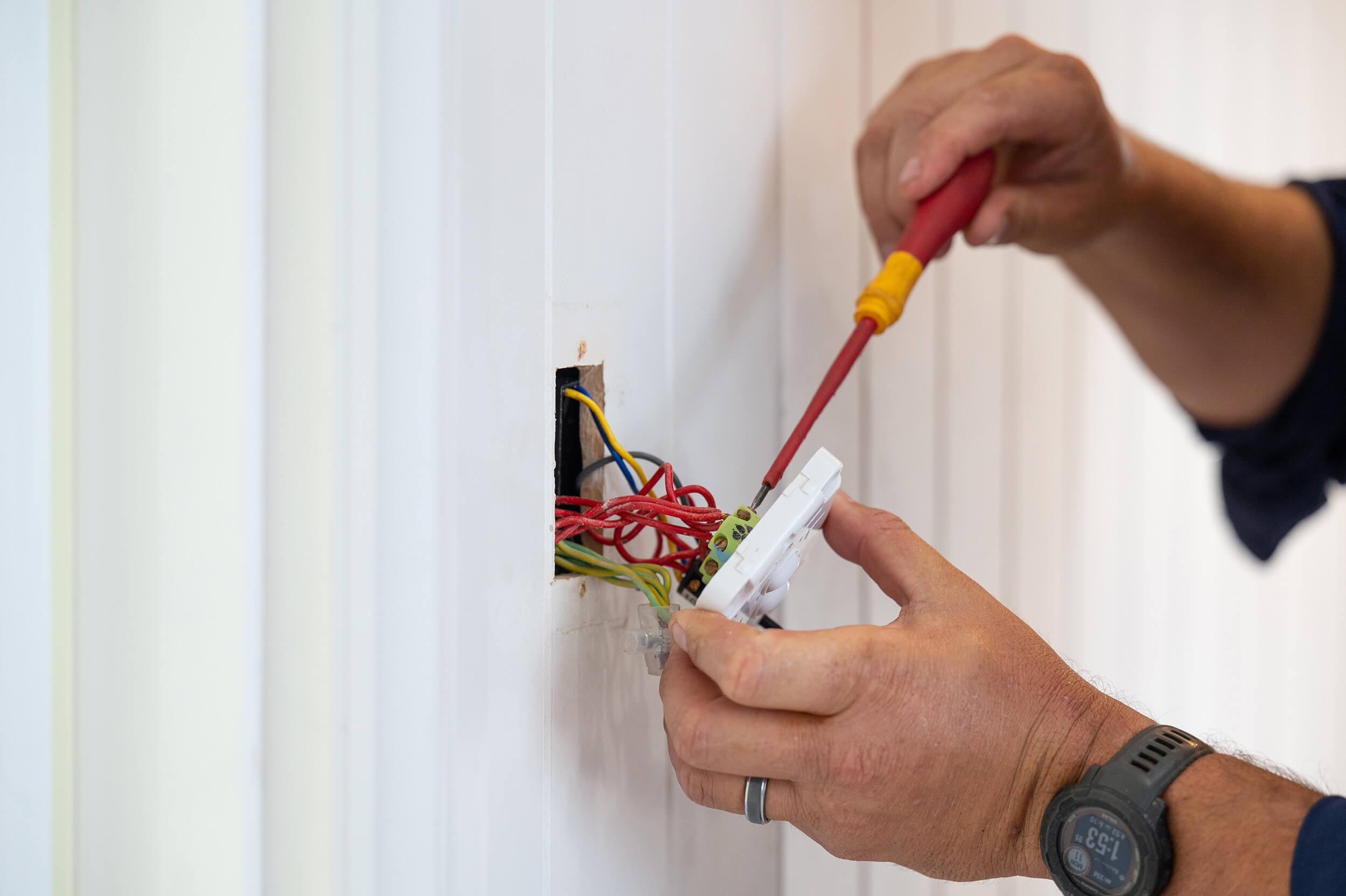Typical Electrical Troubles Every House Owner Need To Understand about
Home owners frequently experience different electric troubles that can affect security and functionality. Issues like flickering lights and stumbled circuit breakers are a lot more typical than lots of recognize. These situations can show much deeper electric issues that warrant focus. Comprehending the indications and dangers related to out-of-date electrical wiring and dead outlets is essential. What procedures can be required to protect against these problems? Discovering these typical electrical problems can disclose important understandings for maintaining a risk-free home setting.

Flickering Lights: Causes and Solutions
Why do some home owners experience flickering lights? Flickering lights can be a common aggravation, usually suggesting underlying electric concerns. One primary cause is loosened or defective links within light fixtures or wiring, which can cause intermittent power supply. Furthermore, utilizing high-wattage devices on the same circuit may trigger voltage fluctuations, causing dimming or flickering. Another prospective issue is an overloaded circuit, where too numerous devices attract power all at once, stressing the electric system. Degraded or outdated circuitry can add to irregular electric flow. In some instances, flickering lights may indicate an issue with the home's electrical panel or service line. Home owners should address flickering lights quickly to avoid possible hazards. Solutions might consist of tightening connections, redistributing home appliance load, or speaking with an accredited electrician for a comprehensive evaluation. Identifying the source can help ensure a steady and secure electric system in the home.
Tripped Circuit Breakers: What You Required to Know
Have property owners ever wondered what triggers their circuit breakers to journey all of a sudden? This typical concern often develops from an overload of electric circuits, where way too many tools draw power concurrently. In such instances, the circuit breaker acts as a safety and security mechanism, interrupting the circulation of power to stop getting too hot and potential hazards. An additional frequent reason is a brief circuit, which occurs when a real-time wire calls a neutral wire, developing a surge of electricity that trips the breaker. Ground faults can also lead to stumbled breakers; these happen when an online wire touches the ground or a based surface, presenting significant safety and security risks. Home owners ought to routinely examine their use of high-wattage appliances to stay clear of overwhelming circuits. In addition, comprehending the feature of breaker can aid them respond appropriately throughout a trip, ensuring their home continues to be secure and well-kept.
Out-of-date Electrical Wiring: Threats and indicators
Outdated electrical wiring can posture significant threats to home owners, usually going undetected up until problems occur. Houses constructed prior to the 1980s might still have light weight aluminum wiring or knob-and-tube systems, which are no more taken into consideration secure. Indicators of outdated electrical wiring consist of flickering lights, frequently tripped breaker, or melting scents near outlets. These signs might recommend that the electric system is loaded down or deteriorating.Additionally, house owners may discover scorch marks around buttons or outlets, which can show getting too hot. The threat of electric fires substantially boosts with outdated wiring, as these systems were not developed to handle contemporary electrical tons. House owners are urged to have their circuitry examined consistently, particularly when renovating or adding brand-new home appliances. By identifying these signs early, they can stay clear of unsafe circumstances and preserve a safer living setting. Upgrading to current electrical standards is an aggressive action in keeping home security and efficiency.
Frequently Blown Fuses: Fixing Tips
Regular blown integrates can suggest underlying electrical concerns that may stem from obsolete electrical wiring or overloaded circuits. House owners experiencing this trouble must initially identify the devices attached to the affected circuit. It is recommended to avoid utilizing multiple high-wattage gadgets at the same time, as this can lead to circuit overload. If the issue persists, checking the circuit box for signs of wear or damages is critical; a faulty circuit box might call for replacement.Additionally, looking for loose links within the circuit can help stop future occurrences. Home owners should additionally confirm that the fuses being utilized are of the proper amperage, as using an inaccurate fuse can intensify the trouble. Seeking advice from a qualified electrician is recommended to evaluate the electric system even more if these troubleshooting ideas do not fix the issue. Attending to these concerns immediately can aid minimize threats and assure the safety of the home's electrical infrastructure.
Dead Outlets: Usual Reasons and Solutions
When a property owner experiences a dead electrical outlet, it can commonly be a resource of stress and complication. Numerous typical causes may bring about this concern. One frequent offender is a tripped circuit breaker, which can be easily reset. Homeowners ought to check their electrical panel to examine if any type of breakers remain in the off setting. An additional possibility is a damaged outlet itself, which may require replacement. Additionally, loose circuitry connections within the electrical outlet can interfere with power circulation, making examination essential.Sometimes, the issue may stem from an overloaded circuit, specifically when numerous devices are linked. In such instances, rearranging the electrical lots can deal with the concern. Home owners need to also take into consideration the age of their circuitry; older systems may call for updates to fulfill contemporary electric needs. If these steps do not rectify the scenario, seeking advice from a certified electrician is recommended to assure safety and appropriate diagnosis.
Electrical Shocks: When to Be Worried
Exactly how can property owners figure out whether an electrical shock warrants issue? Home owners should initially examine the extent and context of the shock. A mild fixed shock, often really felt when touching metal things, is usually safe and typical. If the shock happens while engaging with a plugged-in home appliance or outlet, it may indicate a more significant issue.The area and frequency of the shocks are vital. Repeated shocks from the very same source, specifically in wet locations like bathrooms or kitchens, might signal malfunctioning circuitry or poor grounding. Home owners ought to additionally consider the sensation of the shock; a jolt that creates pain or why not try these out muscle mass tightenings is extra worrying than a plain tingle.If there's any kind of unpredictability, it is a good idea to get in touch with a qualified electrician. Neglecting prospective electric dangers can cause serious safety and security risks, consisting of fire or extreme injury.
Overloaded Circuits: Avoidance and Precaution
Overloaded circuits pose significant threats in residential setups, frequently bring about electric fires or equipment damages (Level 2 Electrician Sydney). Home owners need to acknowledge the indicators of an overloaded circuit, such as regularly tripped breakers or dimming lights. Implementing precautionary safety techniques can assist mitigate these threats and ensure a more secure living atmosphere
Acknowledging Overloaded Circuits
What signs show that a circuit may be strained? House owners must be vigilant for numerous essential signs. Frequently tripped breaker or blown integrates suggest too much load on the circuit. Lowering or flickering lights, specifically when various other devices are in usage, can signify an insufficient power supply. In addition, outlets or buttons that feel warm to the touch might indicate overheating, a prospective fire danger. Unusual buzzing noises from outlets likewise necessitate attention, as they can symbolize electrical issues. Ultimately, if home appliances operate inefficiently or fail to begin, it might be a sign of an overloaded circuit. Recognizing these indications early can assist protect against major electrical problems and promote a much safer home setting.
Preventive Security Practices
To preserve a risk-free and efficient electrical system, homeowners must execute preventative safety methods that attend to prospective circuit overloads. One efficient action is to prevent attaching a lot of devices to a solitary electrical outlet, as this can surpass the circuit's capability. Making use of power strips with integrated breaker can assist distribute power securely. Homeowners should also frequently examine cords and home appliances for damage and change any kind of damaged equipment quickly. It is essential to guarantee that breaker are working appropriately and to be familiar with the overall electrical power being used in each circuit. In addition, seeking advice from a licensed electrical contractor for periodic assessments can determine prospective issues before they escalate, assuring a more secure living atmosphere and lengthening the life expectancy of electric systems.
Often Asked Concerns
How Typically Should I Have My Electrical System Inspected?
Normal assessments of electrical systems are suggested every three to 5 years. House owners ought to consider much more frequent checks if they experience concerns, carry out improvements, or reside in older residential properties to guarantee safety and description security and compliance.
Can I Take Care Of Electric Issues Myself or Hire an Expert?

What Are the Signs of an Electrical Fire Risk?
Signs of an electric fire threat include regularly tripped breaker, flickering lights, shedding odors, blemished electrical outlets, or warm, humming cables. Property owners must remain vigilant and look for specialist support if any one of these indicators are present.
Just how Do I Know if My Home Demands an Electrical Upgrade?
To figure out if a home requires an electrical upgrade, indications include constant breaker trips, outdated wiring, inadequate electrical outlets, flickering lights, and the existence of older electrical panels, suggesting potential security dangers and ineffectiveness.
Are There Certain Safety And Security Tips for Do It Yourself Electric Job?
When taking into consideration DIY electrical work, one should always transform off power, his response use insulated devices, validate circuit functionality, adhere to regional codes, and get in touch with professionals for complex tasks to assure safety and security and stop accidents. One more potential issue is an overloaded circuit, where also many devices attract power concurrently, straining the electric system. The threat of electric fires markedly raises with obsolete circuitry, as these systems were not made to handle modern-day electric tons. Regular blown integrates can indicate underlying electric problems that may stem from outdated circuitry or overloaded circuits. To preserve a risk-free and effective electric system, home owners have to apply preventative safety and security methods that attend to potential circuit overloads. Sydney Level 2 Electrician. Signs of an electric fire risk include regularly stumbled circuit breakers, flickering lights, melting smells, blemished electrical outlets, or warm, humming wires